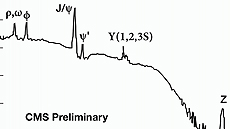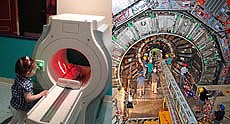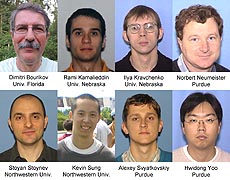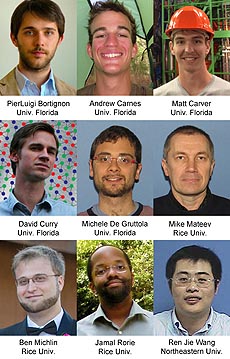|
Have a safe day!
Friday, Feb. 27
3:30 p.m.
Director's Coffee Break - WH2XO
4 p.m.
Joint Experimental-Theoretical Physics Seminar - One West
Speaker: Alex Drlica-Wagner, Fermilab
Title: Gamma-ray Searches for Galactic Dark Matter Substructure
Saturday, Feb. 28
8 p.m.
Fermilab Arts Series - Auditorium
Caladh Nua - Irish
Tickets: $28/$14
Monday, March 2
2 p.m.
Particle Astrophysics Seminar - Curia II
Speaker: Paul Torrey, MIT Kavli Institute
Title: Modeling the Evolution of Galaxy Properties with the Illustris Simulation
3:30 p.m.
Director's Coffee Break - WH2XO
4 p.m.
All Experimenters' Meeting - Curia II
Visit the new labwide calendar to view additional events at Fermilab
|
|
Friday, Feb. 27
- Breakfast: cheese grits
- Breakfast: chorizo and egg burrito
- Backyard pulled-pork burger
- Mediterranean baked tilapia
- Pizza baked pasta
- Tuna melt panino
- General Tso's chicken
- Roasted butternut squash
- Texas-style chili
- Assorted pizza by the slice
Wilson Hall Cafe menu
|
|
Friday, Feb. 27
Dinner
- Roasted butternut squash salad with sherry vinaigrette
- Lobster tail with lemon butter sauce
- Sauteed spinach
- Cauliflower puree
- Chocolate pot de creme with fresh berries
Wednesday, March 4
Lunch
- Chipotle marinated pork
- Tenderloin with pineapple salsa
- Green rice
- Margarita cake with key lime cream cheese frosting
Chez Leon menu
Call x3524 to make your reservation.
|
|
Physics in fast-forward
 |
| During their first run, experiments at the Large Hadron Collider rediscovered 50 years' worth of physics research in a single month. Image courtesy of Dan Green, Fermilab |
In 2010, the brand-spanking-new CMS and ATLAS detectors started taking data for the first time. But the question physicists asked was not, "Where is the Higgs boson?" but rather "Do these things actually work?"
"Each detector is its own prototype," says UCLA physicist Greg Rakness, run coordinator for the CMS experiment. "We don't get trial runs with the LHC. As soon as the accelerator fires up, we're collecting data."
So LHC physicists searched for a few old friends: previously discovered particles.
"We can't say we found a new particle unless we find all the old ones first," says Fermilab senior scientist Dan Green. "Well, you can, but you would be wrong."
Rediscovering 50 years' worth of particle physics research allowed LHC scientists to calibrate their rookie detectors and appraise their experiments' reliability.
The CMS collaboration produced [the above] graph using data from the first million LHC particle collisions identified as interesting by the experiment's trigger. It represents the instances in which the detector saw a pair of muons.
Read more
—Sarah Charley
|
Big animals under a big sky
 |
| The horses by DZero and the bison alike are unfazed by the winter weather. Photos: Bridgett Pygott, FESS |
|
Physicists offer a solution to the puzzle of the origin of matter in the universe
From Astronomy, Feb. 25, 2015
Most of the laws of nature treat particles and antiparticles equally, but stars and planets are made of particles or matter and not antiparticles or antimatter. That asymmetry, which favors matter to a small degree, has puzzled scientists for many years.
New research by University of California, Los Angeles (UCLA) physicists offers a possible solution to the mystery of the origin of matter in the universe.
Alexander Kusenko from UCLA and colleagues propose that the matter-antimatter asymmetry could be related to the Higgs boson particle, which was the subject of prominent news coverage when it was discovered at Switzerland's Large Hadron Collider (LHC) in 2012.
Read more
|
Big bang, deflated? Universe may have had no beginning
From Live Science, Feb. 26, 2015
If a new theory turns out to be true, the universe may not have started with a bang.
In the new formulation, the universe was never a singularity, or an infinitely small and infinitely dense point of matter. In fact, the universe may have no beginning at all.
"Our theory suggests that the age of the universe could be infinite," said study co-author Saurya Das, a theoretical physicist at the University of Lethbridge in Alberta, Canada.
Read more
|
Did dark matter do in the dinosaurs?
From The Economist, Feb. 19, 2015
Every 250m years the sun, with its entourage of planets, completes a circuit of the Milky Way. Its journey around its home galaxy, though, is no stately peregrination. Rather, its orbit oscillates up and down through the galactic disc, the place where most of the galaxy's matter is concentrated. It passes through that disc once every 30m years or so.
This fact has long interested Michael Rampino of New York University. He speculates that it could explain the mass extinctions, such as that of the dinosaurs and many other species 66m years ago, that life on Earth undergoes from time to time. Palaeontologists recognise five such humongous events, when up to 90 percent of species have disappeared. But the fossil record is also littered with smaller, though still significant, blips in the diary of life.
Read more
|
|
Protons in the PET scanner
 |
| Despite the difference in scale, medical PET scanners and the CMS experiment both observe the remnants of particle collisions and use them to reconstruct the source. |
Antimatter is becoming increasingly common in medical technology. One technique, called positron emission tomography (PET scan), follows the flow of a positron-emitting fluid through the body. Wherever an antimatter positron encounters a normal-matter electron, the pair annihilates and produces particles whose trajectories trace back to the point of annihilation, allowing a computer to reconstruct the shape of structures in the body.
Orders of magnitude smaller and at orders of magnitude higher energies, the shape of a single proton is being reconstructed by CMS scientists using a similar technique. A proton is not a smooth sphere or a pinpoint — it is a seething ball of quarks, antiquarks and gluons that are constantly annihilating each other and creating new matter-antimatter pairs. If you could zoom into a proton, you would see more high-energy, short-lived quarks and antiquarks the closer you looked. But exactly how many more at each level of magnification is so difficult to calculate theoretically that it can only be measured and parametrized.
Whenever two protons collide, most of their constituent particles miss each other — usually only one part of each proton actually hits the other. When one of the stricken particles is a quark and the other is an antiquark, they annihilate and may create an electron-positron pair or a muon-antimuon pair, which are observed by the CMS detector. The frequency of these collisions, relative to their energies and the angles of their trajectories, allows scientists to actually see the proton at different levels of magnification.
The CMS collaboration recently published a thorough study of quark-antiquark to electron-positron and muon-antimuon pairs, known collectively as Drell-Yan scattering, as a function of several variables: the incident beam energy (7 and 8 TeV), the energy of the recoiling particle-antiparticle pair and their angles relative to the beamline. These measurements are so precise that they can be used to improve models of the shape of the proton: Some variations of the model parameters are compatible with the measurement, others are not. In that sense, it is like a scan of the shape of the proton.
This measurement has implications beyond just understanding the proton better: Nearly every other LHC result depends on these models. Measuring Drell-Yan scattering with exquisite precision is an indirect way of shrinking uncertainties in Higgs discoveries and extending the reach of hundreds of searches for new physics.
—Jim Pivarski
 |
| These U.S. CMS scientists are the primary analysts for this result. |
 |
| These physicists and engineers are making a big contribution to the upgrade and recommissioning of the CMS muon trigger system. |
|
|